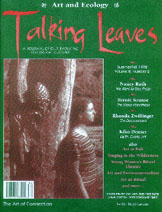Several years later, back in Manhattan, we shared a studio for a time. As my shifting interests began taking me away from painting, Rhonda became more intensely focused on her work, discovering her own unique creative voice, and making serious waves in the embryonic art scene that was developing in the East Village. Within a couple of years she was at the forefront of what was, for a few years in the mid-eighties, the most vibrant and exciting movement on the international art scene. The East Village scene, composed of a multicultural collage of young artists from mostly working class families, boldly and outrageously challenged the "high art" establishment, which at the time consisted almost exclusively of white, male painters whose work was bought and traded as "blue chip" commodities in the exclusive galleries of SoHo and the upper east side. (This, sadly, is still the case--just leaf through a recent copy of ArtForum or Art in America.)
Rhonda Zwillinger
The Dispossessed
1998 Fall | Rhonda Zwillinger
Editor's Note: I first met Rhonda Zwillinger in Provincetown in the summer of 1975. Aspiring young artists, we were both taking refuge from the oppressiveness of the New York City summer and looking for inspiration in the crystal clear light, beautiful beaches, and laid back lifestyle of this Cape Cod town whose years as a serious artist colony were just beginning to wane. Rhonda was also taking a break from her demanding role as a Jewish Brooklyn mother/housewife, having married her childhood sweetheart and given birth to a child before seriously beginning her path as an artist.
